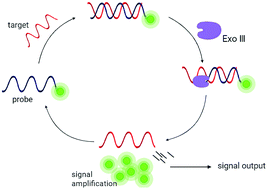Recent advances in the exonuclease III-assisted target signal amplification strategy for nucleic acid detection
Abstract
The detection of nucleic acids has become significantly important in molecular diagnostics, gene therapy, mutation analysis, forensic investigations and biomedical development, and so on. In recent years, exonuclease III (Exo III) as an enzyme in the 3′–5′ exonuclease family has evolved as a frequently used technique for signal amplification of low level DNA target detection. Different from the traditional target amplification strategies, the Exo III-assisted amplification strategy has been used for target DNA detection through directly amplifying the amounts of signal reagents. The Exo III-assisted amplification strategy has its unique advantages and characters, because the character of non-specific recognition of Exo III can overcome the limitation of a target-to-probe ratio of 1 : 1 in the traditional nucleic acid hybridization assay and acquire higher sensitivity. In this review, we selectively discuss the recent advances in the Exo III-assisted amplification strategy, including the amplification strategy integrated with nanomaterials, biosensors, hairpin probes and other nucleic acid detection methods. We also discuss the strengths and limitations of each strategy and methods to overcome the limitations.

- This article is part of the themed collection: Analytical Methods Review Articles 2021


 Please wait while we load your content...
Please wait while we load your content...